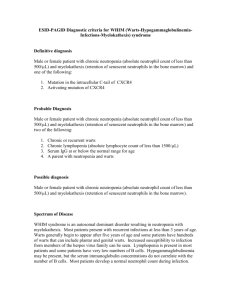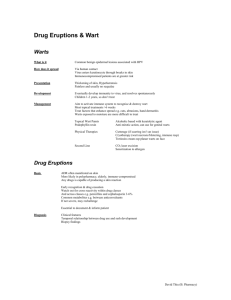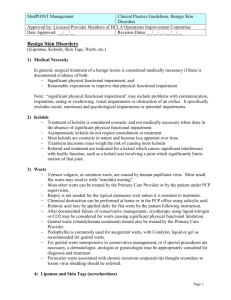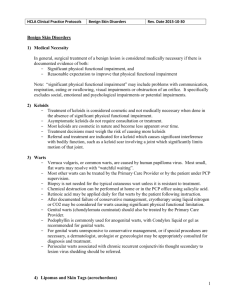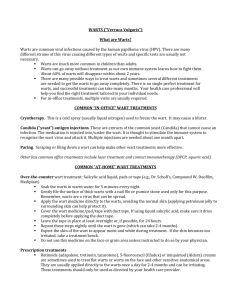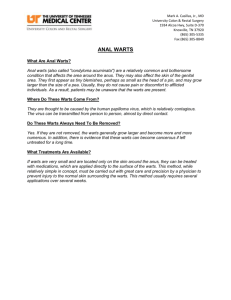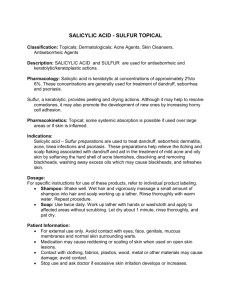Document 14233927
advertisement
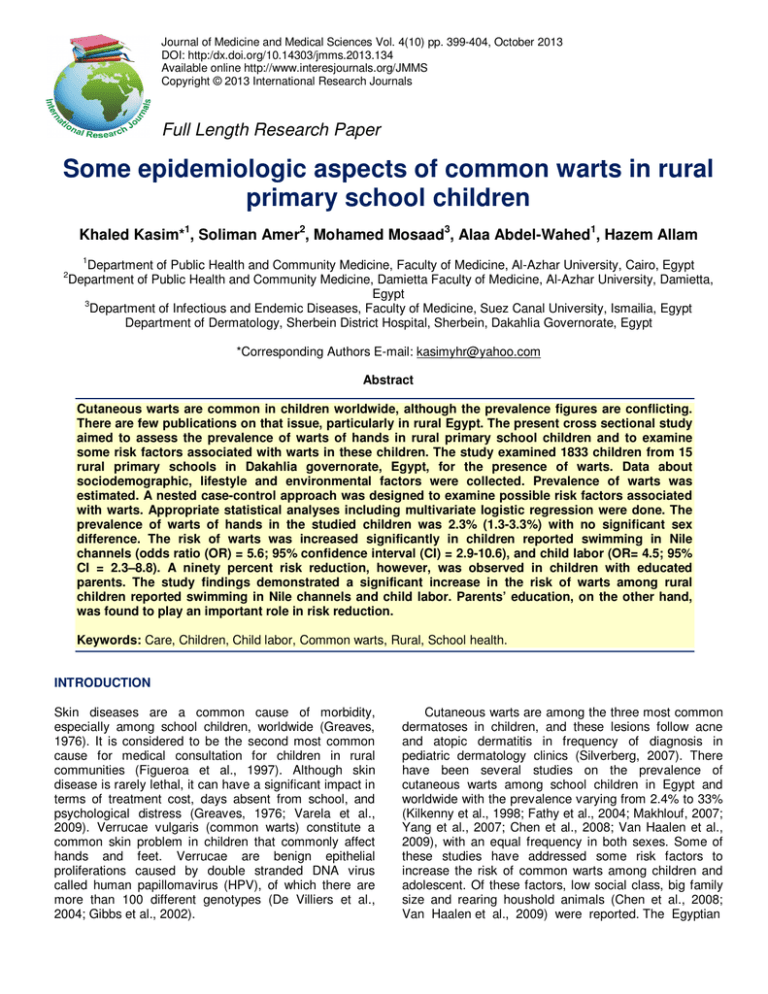
Journal of Medicine and Medical Sciences Vol. 4(10) pp. 399-404, October 2013 DOI: http:/dx.doi.org/10.14303/jmms.2013.134 Available online http://www.interesjournals.org/JMMS Copyright © 2013 International Research Journals Full Length Research Paper Some epidemiologic aspects of common warts in rural primary school children Khaled Kasim*1, Soliman Amer2, Mohamed Mosaad3, Alaa Abdel-Wahed1, Hazem Allam 1 Department of Public Health and Community Medicine, Faculty of Medicine, Al-Azhar University, Cairo, Egypt Department of Public Health and Community Medicine, Damietta Faculty of Medicine, Al-Azhar University, Damietta, Egypt 3 Department of Infectious and Endemic Diseases, Faculty of Medicine, Suez Canal University, Ismailia, Egypt Department of Dermatology, Sherbein District Hospital, Sherbein, Dakahlia Governorate, Egypt 2 *Corresponding Authors E-mail: kasimyhr@yahoo.com Abstract Cutaneous warts are common in children worldwide, although the prevalence figures are conflicting. There are few publications on that issue, particularly in rural Egypt. The present cross sectional study aimed to assess the prevalence of warts of hands in rural primary school children and to examine some risk factors associated with warts in these children. The study examined 1833 children from 15 rural primary schools in Dakahlia governorate, Egypt, for the presence of warts. Data about sociodemographic, lifestyle and environmental factors were collected. Prevalence of warts was estimated. A nested case-control approach was designed to examine possible risk factors associated with warts. Appropriate statistical analyses including multivariate logistic regression were done. The prevalence of warts of hands in the studied children was 2.3% (1.3-3.3%) with no significant sex difference. The risk of warts was increased significantly in children reported swimming in Nile channels (odds ratio (OR) = 5.6; 95% confidence interval (CI) = 2.9-10.6), and child labor (OR= 4.5; 95% CI = 2.3–8.8). A ninety percent risk reduction, however, was observed in children with educated parents. The study findings demonstrated a significant increase in the risk of warts among rural children reported swimming in Nile channels and child labor. Parents’ education, on the other hand, was found to play an important role in risk reduction. Keywords: Care, Children, Child labor, Common warts, Rural, School health. INTRODUCTION Skin diseases are a common cause of morbidity, especially among school children, worldwide (Greaves, 1976). It is considered to be the second most common cause for medical consultation for children in rural communities (Figueroa et al., 1997). Although skin disease is rarely lethal, it can have a significant impact in terms of treatment cost, days absent from school, and psychological distress (Greaves, 1976; Varela et al., 2009). Verrucae vulgaris (common warts) constitute a common skin problem in children that commonly affect hands and feet. Verrucae are benign epithelial proliferations caused by double stranded DNA virus called human papillomavirus (HPV), of which there are more than 100 different genotypes (De Villiers et al., 2004; Gibbs et al., 2002). Cutaneous warts are among the three most common dermatoses in children, and these lesions follow acne and atopic dermatitis in frequency of diagnosis in pediatric dermatology clinics (Silverberg, 2007). There have been several studies on the prevalence of cutaneous warts among school children in Egypt and worldwide with the prevalence varying from 2.4% to 33% (Kilkenny et al., 1998; Fathy et al., 2004; Makhlouf, 2007; Yang et al., 2007; Chen et al., 2008; Van Haalen et al., 2009), with an equal frequency in both sexes. Some of these studies have addressed some risk factors to increase the risk of common warts among children and adolescent. Of these factors, low social class, big family size and rearing houshold animals (Chen et al., 2008; Van Haalen et al., 2009) were reported. The Egyptian 400 J. Med. Med. Sci. studies in this review, however, were conducted in urban areas in Cairo (Makhlouf, 2007) and Mansoura (Fathy et al., 2004) cities. Currently, there is still little information about the epidemiology of warts in rural Egyptian children. The present cross sectional study aimed to improve our knowledge about the epidemiology of common warts among rural primary school children in Egypt as a school health problem. The specific objectives of this study was to assess the prevalence of common warts of hands in primary school children in rural communities and to examine the possible risk factors associated with development of warts in these children. MATERIALS AND METHODS The present study recruited 6th grade primary school children from El-Dakahlia governorate, Delta region, Egypt to determine the prevalence of common warts of hand among them and to examine the possible associated risk factors. A multistage random sampling technique was used to select the studied children from all rural primary schools in the governorate. The sample size is calculated according to the average prevalence of verruca vulgaris in urban school children reported in previous Egyptian studies (Fathy et al., 2004; Makhlouf, 2007) and to an assumed precision of 0.01 with confidence interval of 95% and probability value of 0.05. All children were eligible, and no exclusion criteria were used. The children were interviewed and examined individually in the classroom where the school nurse, doctor and/or the class teacher were attending. A child was diagnosed to have a verruca vulgaris (common wart) in presence of a sessile, firm, variable sized papule, with rough papillary surface, skin colored or darker (Sterling et al., 2001; Kirnbauer et al., 2008; Sterling, 2010). Out of 1870 children interviewed in 15 rural primary schools in the studied governorate, 1833 agreed to participate (98% response rate). Those who refused to participate did not differ significantly from those participated regarding socio-demographic characteristics. Children diagnosed to have warts were considered as cases and wart-free children were considered as controls in order to build up a nested case control approach to allow investigation of the possible risk factors associated with the development of common warts among these children. Based on review of literature, a questionnaire was designed to collect relevant data from the studied children to investigate possible risk factors of warts. The questionnaire included questions about: (i) Sociodemographic factors: age, sex, family size and parents’ education and occupation (ii) Lifestyle factors: swimming, sport practice and working after school time (child labor), and (iii) Environmental factors: presence of household animals (farm, pet and domestic birds). The validity of the used questionnaire was obtained from discussions with a dermatologist, an infectious disease consultant, and two community medicine consultants. All data analysis was performed by using Statistical Analysis System software package (SAS, 1999). In order to compare the distribution of the studied factors in diseased and non diseased children, χ2 tests for the categorical variables and t test for the continuous variables were used. The level of statistical significance was defined as P ≤ 0.05. Multivariate logistic regression analyses were used to estimate odds ratios (OR) and their 95% confidence intervals (95% CI) for the association of sociodemographic, lifestyle and environmental factors with the risk of common warts in the studied children. The school officials were clearly informed about the aim and scope of the research. No one of the studied was obliged to participate in the study. Furthermore, ethical consideration was considered to avoid physical or emotional harm, and to ensure confidentiality and privacy of the collected data. RESULTS The prevalence of wart of hand in the studied children was 2.3% (95% CI = 1.3-3.3), with no statistically significant difference by sex. The prevalence was 2.4% and 2.2% in male and female children respectively. Table 1 presents the sociodemographic characteristics of the studied sample by wart. There were no statistically significant differences between the mean age and sex distribution among the studied children with and without warts. There have been highly statistically significant differences between children with warts and without warts regarding their parents’ education and occupation. The lower percent of education and professional work was among children with warts. Also, children reported with big size family showed a higher prevalence of warts with statistically significant difference. Table 2 displays the distribution of the studied children by lifestyle and environmental factors by warts. There have been highly statistically significant differences between children with and without warts regarding swimming in Nile channels and working after school time (child labor) (p <.0001). Also, there have been statistically significant differences between diseased and non diseased children with regard to the presence of household animals. On the other hand, no statistically significant difference was observed between both groups regarding regular sport practice (football practice). Table 3 presents the adjusted odds ratios and their 95% confidence intervals for the association of warts with the studied sociodemographic factors. Sex of children appeared to have no role in the risk of warts with an adjusted OR of 0.96 (CI= 0.50-1.70). The risk of warts, however, showed about double folds increased risk in children reported with family size more than five. On the Kasim et al. 401 Table 1. Characteristics of the studied children by their sociodemographic factors and warts Warts (n= 42) 11.6 ± 0.33 No warts (n= 1791) 11.7 ± 0.34 22 (52.0) 20 (48.0) 904 (50.5) 887 (49.5) 16 (38.0) 26 (62.0) 980 (55.0) 811 (45.0) 5 (12.0) 31 (74.0) 6 (14.0) 78 (4.0) 908 (51.0) 805 (45.0) <.0001** 8 (19.0) 29 (69.0) 5 (12.0) 110 (6.0) 958 (54.0) 723 (40.0) <.0001** Father’s occupation Non skilled work Skilled work Professional work 8 (19.0) 29 (69.0) 5 (12.0) 253 (14.0) 1323 (74.0) 215 (12.0) Mother’s occupation House wife Skilled work Professional work 33 (78.0) 7 (17.0) 2 (5.0) 1454 (80.7) 221 (12.3) 116 (7.0) Characteristics* Age (mean ± SD) Sex Male Female Family size ≤5 >5 Father’s education Illiterate Less than 2ry school 2ry school and higher Mother’s education Illiterate Less than 2ry school 2ry school and higher * p value 0.85 0.80 0.03* <.0001** <.0001** Data are presented by mean ± SD or n (%). Table 2. Distribution of the studied children by lifestyle and environmental factors according to warts Lifestyle factor Swimming in Nile channels No Yes Child labor No Yes Regular sport practice No Yes Farm animals No Yes Pet animals No Yes Domestic birds No Yes * Warts (n= 42) No. No warts (n= 1791) No. 22 (52.0) 20 (48.0) 1520 (85.0) 271 (15.0) <.0001* 21(50.0) 21 (50.0) 1402 (94.0) 389 (6.0) <.0001* 22 (52.0) 20 (48.0) 988 (55.0) 803 (45.0) 0.88 9 (21.0) 33 (79.0) 547 (31.0) 1244 (69.0) 0.002* 8 (19.0) 34 (81.0) 458 (26.0) 1333 (74.0) 0.002* 2 (5.0) 40 (95.0) 158 (9.0) 1633 (91.0) <.0001* p value Significant other hand, parents’ education and occupation of the studied children appeared to have an important role in the risk of warts where the risk is markedly reduced among those children with educated and professional work parents. The risk was reduced by about 90% in those children with educated parents. 402 J. Med. Med. Sci. Table 3. Adjusted odds ratios (ORs) and 95% confidence intervals (CIs) for the association of warts with the studied sociodemographic factors Factor Warts No warts OR (95% CI) Sex* Female Male 22 20 904 887 1.0 (Ref.) 0.96 (0.50 – 1.70) 16 26 980 811 1.0 (Ref.) 1.8 (0.80– 4.30) 5 31 6 78 908 805 1.0 (Ref.) 0.49 (0.15 - 0.89) 0.11 (0.04 - 0.39) 8 29 5 110 958 723 1.0 (Ref.) 0.43 (0.10 - 0.42) 0.10 (0.03 - 0.30) 8 29 5 253 1323 215 1.0 (Ref.) 0.72 (0.32 - 1.6) 0.75 (0.24 - 2.3) 33 7 2 1454 221 116 1.0 (Ref.) 1.4 (0.62 - 3.3) 0.75 (0.19 - 3.2) * * Family income ≤5 >5 Father’s education* Illiterate Less than 2ry school 2ry school and higher * Mother’s education Illiterate Less than 2ry school 2ry school and higher Father’s occupation* Non skilled worker Skilled worker Professional worker Mother’s occupation House wife Skilled worker Professional worker * OR of these factors were adjusted by factors in Table 4. Table 4. Odds ratios (ORs) and 95% confidence intervals (CIs) for the association of warts with the studied lifestyle and environmental factors Factor Warts No warts OR (95% CI) 22 20 1520 271 1.0 (Ref.) 5.6 (2.9 - 10.6) 21 21 1402 389 1.0 (Ref.) 4.5 (2.3 - 8.8) 22 20 988 803 1.0 (Ref.) 1.20 (0.60 - 4.2) 9 33 547 1244 1.0 (Ref.) 1.6 (0.75 - 3.3) 8 34 458 1333 1.0 (Ref.) 1.7 (0.67 - 3.2) 2 40 158 1633 1.0 (Ref.) 1.9 (0.50 - 8.1) * Swimming in Nile channels No Yes Child labor* No Yes Regular sport practice* No Yes Farm animals* No Yes Pet animals* No Yes Domestic birds No Yes * OR of these factors were adjusted by factors in Table 3. Table 4 shows the adjusted odds ratios and their 95% confidence intervals for the association of warts with the studied lifestyle and environmental factors by residence. The risk of warts was significantly increased in association with child labor (OR= 4.5; CI 2.3-8.8). Similarly, swimming in Nile channels was associated with a significant increased risk with an adjusted OR of 5.6 (CI= 2.9-10.6). The presence of household animals was Kasim et al. 403 associated with a non significant increased risk of warts. The risk was 1.6, 1.7 and 1.9 in children reported rearing farm animals, pet animals, and domestic birds respectively. Regular sport practice, however, appeared to have a minimal role in the risk of warts in the studied children. DISCUSSION The present study revealed the prevalence of common warts of hands in the studied children to be 2.3%. A similar prevalence of warts in primary school children was also reported in different studies conducted in Mansoura city, Egypt (Fathy et al., 2004), Taiwan (Yang et al., 2007) and Romania (Popescu, 1999). The prevalence in these studies was 2.5%, 2.4% and 2.8% respectively. A higher prevalence rate, however, was reported in an Egyptian study conducted in Bab El-Sharia region, Cairo, Egypt (Makhlouf, 2007), and in a regional study conducted in Saudi Arabia, in Al Hassa rural area (Amin et al., 2011). The prevalence rate in these two studies was 7.5% and 4.5% respectively. Primary school children of all grades were included in these studies, and their estimated prevalence included common warts of both hands and feet. The high prevalence rate observed in these and other studies may give an idea about the availability of school health care services. Availability of health care services in schools may help an early diagnosis and prompt treatment of diseased children (Wallace, 2008), which in turn shortens disease duration and decrease its prevalence (Rothman and Greenland, 2008). The prevalence of warts in the present study was not affected by sex of the studied children with an odds ratio approach null. This finding appeared consistent with the results of several previous studies conducted in different countries, including Egypt (Kilkenny et al., 1998; Fathy et al., 2004; Makhlouf, 2007; Yang et al., 2007; Chen et al., 2008; Van Haalen et al., 2009). The risk of warts in this study is found to increase significantly in children reported swimming in Nile channels with an adjusted OR of 5.6 (95% CI= 2.9 10.6). It is generally accepted that HPV infection via the environment is more likely to occur if the skin is macerated and in contact with roughened surfaces, the conditions which are common in swimming and communal washing areas (Sterling et al., 2001; Gibbs, 2008). The study findings revealed a significant increase in the risk of warts in association with child labor, with an odds ratio of 4.5 (95% CI= 2.3-8.8). Child labor is highly relevant to the socioeconomic status of the family which in turn affects the incidence and prevalence of warts (Yang et al., 2007; Van Haalen et al., 2009). The presence of houshold animals was also associated with a non significant increased risk of warts in the studied children. The estimated risk was 1.6 (95% CI= 0.75-3.3) for farm animals, 1.7 (95% CI= 0.67 – 3.2) for pet animals and 1.9 (95% CI= 0.50 – 8.1) for domestic birds. These findings coincide with the results of previous studies (Chen et al., 2008; Van Haalen et al., 2009), and confirm the well-settled role of environmental factors which profoundly influence the occurrence of warts (Sterling et al., 2001; Gibbs, 2008). Presence of household animals is a feature of rural communities in Egypt which contributes to poor standards of hygiene favoring spread of contagious skin diseases. Regular sport practice, however, appeared to have a minimal role in the risk of warts development in the studied children. The OR for the association of sport practice with warts was 1.20 (95% CI= 60-4.2), and this finding appeared consistent with the study results of Van Haalen et al. Family size has also been associated with an increased risk of warts in children reported with big family size that is more than five, although it is not significant. Similarly, the risk of warts is increased in children with a family member with warts (Van Haalen et al., 2009), and in children with big family size and low social class (Chen et al., 2008; Van Haalen et al., 2009). Big family size, particularly in rural areas, usually suffers from overcrowding and bad personal hygiene such as; shared clothing and fomite. These factors might help the transmission of infectious skin diseases. The study findings, on the other hand, revealed a significant and marked risk reduction in children reported education of their parents. In these children, the risk is reduced by 90%. Also, the risk of warts is reduced by 25% in children with professional worker parents, although not significant. These findings coincide with the results of a cross-sectional study carried out in Magong, Taiwan and included 3273 children aged 6-11 years (Chen et al., 2008). In that study, the authors reported that having a father with a manual occupation was associated with an increased risk for having cutaneous warts. Education and occupations of the individuals certainly affect health awareness and standards of hygiene within the family e.g. an educated parent will seek medical help if his son has a wart (Cochrane et al., 1982, Chou et al., 2010). Although this attitude is less likely to decrease wart incidence, it may decrease wart prevalence through shortening disease duration where prevalence is known to decrease by decreasing the duration of the disease even with increased incidence (Rothman and Greenland, 2008). The present study appeared to have a number of strengths that includes a school based study, the matter which consolidates the study findings. The sample was relatively large in size with a high response rate of interviewed children in the studied 15 schools. The study questionnaire was comprehensive and included most of the possible risk factors associated with the development of warts. Limitations of this study should also not be overlooked. The study reported only the warts of the 404 J. Med. Med. Sci. hands in the studied children and warts in other body sites were not reported. The role of age as a risk factor in development of warts could not be assessed in this study due to the narrow range of age in the study sample. Also, the per capita income of the child’s family could not be assessed through the questionnaire in this young age. However, the data collected about children parents’ education, occupation and family size might reflect the per capita income in this study. In summary, the present study found the prevalence of warts of hands in rural primary school children to be 2.3% with no significant sex difference. The main risk factors implicated in the development of warts in these children were swimming in Nile channels, child labor, and presence of household animals and big family size. On the other hand, however, warts seemed to be less common in children with educated parents. ACKNOWLEDGMENT We would like to thank all primary school children participated in this study. We also acknowledge school doctors, nurses, teachers and school officials of all visited schools for help and co-operation. REFERENCES Amin TT, Ali, A, Kaliyadan F (2011). Skin disorders among male primary school children in Al Hassa, Saudi Arabia: prevalence and socio-demographic correlates-a comparison of urban and rural populations. Rural and Remote Health; 11: 1517. Chen GY, Cheng YW, Wang CY, Hsu TJ, Hsu MM, Yang PT, Chen WC (2008). Prevalence of skin diseases among schoolchildren in Magong, Penghu, Taiwan: a community-based clinical survey. J Formosan Med Assoc; 107(1):21-9. Chou YS, Liu JT, Grossman M, Joyce T (2010). Parental Education and Child Health: Evidence from a Natural Experiment in Taiwan. Amer Econ J: Applied Economics; 2(1): 33-61. Cochrane SH, Leslie J, O'Hara DJ (1982). Parental education and child health: intracountry evidence. Health Policy Education; 2(3-4):21350. De Villiers EM, Fauquet C, Broker TR, Bernard HU, zur Hausen H (2004). Classification of papillomaviruses. Virology; 324:17-27. Fathy H, El-Mongy S, Baker NI, Abdel-Azim Z, El-Gilany A (2004). Prevalence of skin diseases among students with disabilities in Mansoura, Egypt. Eastern Mediterranean Health J; 10(3):416-424. Figueroa JI, Hawranek T, Abraha A, Hay RJ (1997). Prevalence of skin diseases in school children in rural and urban communities in the Illubabor province, south-western Ethiopia: a preliminary survey. J. Eur. Acad. Dermatol. Venereol; 9: 142-148. Gibbs S (2008). Local treatments for cutaneous warts. In: Evidencebased Dermatology. Williams H, Bigby M, Diepgen T, Herxheimer A, nd Naldi L and Rzany B (Eds). 2 edition. Malden, Massachusetts: Blackwell Publishing, p347-353. Gibbs S, Harvey I, Sterling J, Stark R (2002). Local treatments for cutaneous warts: systematic review. Br. Med. J. 325:461. Greaves MW. Dermatology (1976). Practitioner; 217: 585-590. Kilkenny M, Merlin K, Young R, Marks R (1998). The prevalence of common skin conditions in Australian school students: Common, plane and plantar viral warts. British Journal of Dermatology; 138:840-845. Kirnbauer R, Lenz P, Okun MM (2008). Human Papillomavirus. In: nd Dermatology. Bolognia JL, Jorizzo JL and Rapini RP (Eds). 2 edition. London: Mosby, p1183-1198. Makhlouf NN (2007). The prevalence of dermatological diseases among school children in Bab El-Shaareya region, Cairo city. Master Thesis of Dermatology and Venereology. Faculty of Medicine, Al-Azhar University, p67. Popescu R, Popescu CM, Williams HC, Forsea D (1999). The prevalence of skin conditions in Romanian school children. Br J Dermatol; 140:891-896. Rothman KJ, Greenland S (2008). Measures of occurrence. In: Modern rd Epidemiology. Rothman KJ, Greenland S and Lash TL (Eds). 3 Edition. Philadelphia: Lippincott Williams & Wilkins, p32-50. SAS Institute Inc. (1999). Propriety software release 8.2. SAS Institute Inc, Cary, NC. Silverberg NB (2007). Human papillomavirus infections in children. Pediatric Infectious Diseases Revisited. Schroten H and Wirth S (Eds). Basel: Birkhäuser Verlag., p365-390. Sterling JC (2010). Virus Infections; Human papillomaviruses. In: Rook’s Textbook of Dermatology. Burns T, Breathnach S, Cox N th and Griffiths C (Eds). 8 edition. Oxford: Blackwell Science Ltd: 2 (33):37-60. Sterling JC, Handfield-Jones S, Hudson PM (2001). British Association of Dermatologists. Guidelines for the management of cutaneous warts. Br. J. Dermatol. 144(1): 4-11. Van Haalen FM, Bruggink SC, Gussekloo J, Assendelft WJ, Eekhof JA (2009). Warts in primary schoolchildren: prevalence and relation with environmental factors. Br. J. Dermatol. 161(1):148-152. Varela A, Tremaine AM, Gewirtzman A, Satyaprakash A, Mendoza N, Ravanfar P, Tyring SK (2009). Common viral infections, Human Papillomavirus. In: Skin Infections Diagnosis and Treatment. Hall JC and Hall BJ (Eds). New York: Cambridge University Press, p23-41. Wallace RB (2008). Epidemiology and Public Health. In: MaxcyRosenau-Last Public Health & Preventive Medicine. Wallace RB, th Kohatsu N and Last JM (Eds). 15 edition. New York: McGraw-Hill; p5-26. Yang YC, Cheng YW, Lai CS, Chen W (2007). Prevalence of childhood acne, ephelides, warts, atopic dermatitis, psoriasis, alopecia areata and keloid in Kaohsiung County, Taiwan: a community-based clinical survey. J. Eur. Acad. Dermatol. Venereol. 21:643-649. How to cite this article: Kasim K, Amer S, Mosaad M, Abdel-Wahed A, Allam H (2013). Some epidemiologic aspects of common warts in rural primary school children. J. Med. Med. Sci. 4(10):399-404
